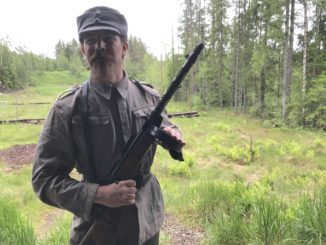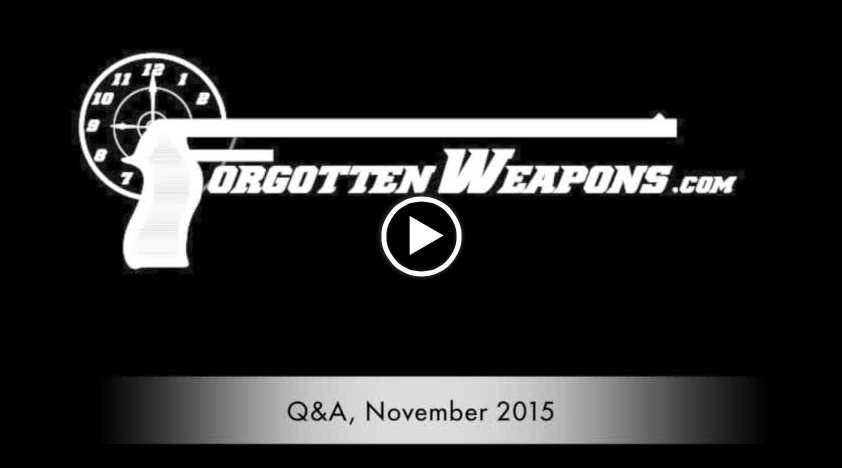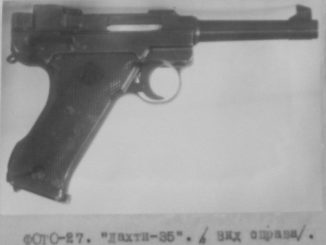When Finland decided to replace the Luger as its service handgun, they turned to Finland’s most famous arms designer, Aimo Lahti. After a few iterations, Lahti devised a short recoil semiautomatic pistol with a vertically traveling locking block, not too different from a Bergmann 1910 or Type 94 Nambu. It was adopted in 1935, but production did not really begin in earnest until 1939 at the VKT rifle factory. Several variations were made as elements of the gun were simplified to speed up production, and the design was also licensed to the Swedish Husqvarna company, which manufactured nearly 10 times as many of the pistols as VKT eventually did.
In today’s video we will look at each of the variations, including one with an original shoulder stock and the early and late military guns as well as the post-war commercial guns marked Valmet instead of VKT.




“turned to Finland’s most famous arms designer, Aimo Lahti”
Was there any competitors? Either native (from Finland) or foreign? Was it compared against any other automatic pistol before adoption?
My impression of the bolt accelerator was that the ammunition provided for testing was quite mild, like civilian load or even [horrible Italian pistol] level…
ln the years when this pistol introduced, shrinked rifle type handgun construction with a small mass bolt mounted in the barrel extention, had nearly gone off as replaced by all Browning type slide with the barrel inside. What was the cause for Mr. Lahti to choose this old fashioned form… Higher bolt speed through lesser mass… But it would have bigger outer space to get effected from cold climate conditions. Besides, the accerelator mounted in the barrel extention would not only fasten the bolt speed but slow the backward motion of this upper receiver resulting quicker return speed of bolt which giving unsufficient rising time for magazine follower to pop up a fresh round on chambering path in cold and wet climate conditions eventually causing malfunctions. Seems not a reasonable design for the kind of geograpy.
According to the lock piece similarity, Bergman uses an “O” shaped sliding locking block working with recesses cut under the bolt, this pistol with a reversed “U” shaped part over the bolt. Type 94 Nambu which having a barrel in the slide construction, works with a back and forth and up and down sliding lock piece in assocation with lateral notches cut at the both side of slide walls.
“cause for Mr. Lahti to choose this old fashioned form”
First answer which I got in my mind was: Lahti was impressed by Parabellum Pistole and so follow its aesthetics (including exposed barrel) and in effect also balance.
Thus L-35, MP 18, Parabellum-Pistole, SUOMI sub-machine guns would make tetragon of Doppelgänger as both me be described more or less as Lahti way to make sub-machine gun (SUOMI) or automatic pistol (L-35) and being similar aesthetic-wise to German designs.
However I am not sure if it was Lahti decision to make automatic pistol in that layout or someone else – Finnish forces used earlier Parabellum-Pistole so maybe someone state new automatic pistol should be similar to that?
–
Other answer might be patent-dodging, however I am not sure how patents in Finland work as it did not exist as sovereign entity of international law before 1918.
Nonetheless if that information from English Wikipedia query:
In 1932 Lahti and the Ministry of Defence signed two important agreements about Lahti’s earnings and other economic benefits. It also gave the government rights to use and sell his designs.
is true, that would be logical for Ministry of Defence to motivate Lahti to create new designs.
Lastly I think it is possible that L-35 was created as companion for SUOMI sub-machine gun, to check if this is true would require access to VKT correspondence with foreign clients – maybe someone was content with SUOMI sub-machine gun and send request for proposal for automatic pistol of same caliber – remember that in 1935 9×19 automatic pistols were less popular than in 2018, unlike 2018 not every bigger manufacturers of automatic pistols offered automatic pistol in that caliber.
All above are hypothesis, maybe some having more knowledge about Lahti work will be able to deny or prove it.
My fail: I now checked that SUOMI sub-machine gun is product of Oy Tikkakoski Ab not VKT, so rather Oy Tikkakoski Ab correspondence would show if any foreign user of SUOMI was interested in matching automatic pistol. This spawn new question: what was relation between Oy Tikkakoski Ab and VKT, they were only aware of each other existence? competitors? make some cooperation?
VKT was a state factory originally established to make the L-26 LMG and other Army work. It didn’t have the capacity to make SMGs, because of all other orders.
Tikkakoski was a private company making all kinds of metal work, but later concentrated on firearms. Lahti and his private company ordered the first Suomi-26 SMGs from Tikkakoski, before selling all his patents to the Army. Later Tikkakoski made lots of barrels and overhaul work for Maxim MGs and later also rifle barrels. And of course Suomi-31 SMGs. Most of the time Tikkakoski was owned by a German arms dealer Willi Daugs, because of that it was taken by Soviet Union after the war.
“cause for Mr. Lahti to choose this old fashioned for”
I start searching for patent, in google his patent might be found under inventor:(Lahti Aimo Johannes), I found some patents around SUOMI sub-machine gun, machine gun but what seems to me to be most probably L-35 patent is FI15716A:
https://patents.google.com/patent/FI15716A/en?inventor=Lahti+Aimo+Johannes
which name was translated to English as Receding barrel and a pistol equipped with a lock-blocked and original is Perääntyvällä piipulla ja salvatulla lukolla varustettu pistooli. It is from 1934 which fits timeline-wise, sadly I was not able to find text or drawings of that patent.
Thanks Daweo. It seems the necessity of an accelerator which Mr. Lahti thought as a must in old Swedish climate, gave way such a preference. Old fashioned bolt in the barrel extention construction seemed easier accepting to mount an accelerator.
Some useful info here;http://georgy-konstantinovich-zhukov.tumblr.com/post/76241675380/animation-of-the-locking-block-and-accelerator-of
My buddy has a Swedish- made example without any markings other than the serial number, they even milled away the logo from the grips. One of a 500- gun batch of “neutral” pistols which were sold to Norwegian resistance and/or used by Swedish intelligence agents abroad; the idea was the Germans should be unable to trace any captured examples back to neutral Sweden.
For your information, the wartime Swedish guns may be even more fragile than the Finnish ones. Sweden at tje time were desperate for all sorts of weapons in case they got dragged into the war, and pistols were a low priority so didn’t get the best steel (unlike antiaircraft guns). My friend’s M40 has a cracked and deformed slide, not near the accellerator but around the lockin lugs.
“One of a 500- gun batch of “neutral” pistols which were sold to Norwegian resistance and/or used by Swedish intelligence agents abroad; ”
Photos of such sample: http://www.gotavapen.se/gota/m40/pist40_5.htm
according to info in that link:
The C-Bureau later became “The Technical Office” which was a forerunner of today’s Military Secrete service in Sweden. These pistols were given to secrete agents and they were occasionally found in Norway.
Many collectors assume that these pistols were intended for the Danish and Norwegian partisans, but this has been proven wrong.
On the neutral Husquarnas:
I don’t know what Swedish records say about these, the books were obviously obfuscated at the time. However, Norwegian wartime records are pretty clear on the neutral guns being made to a Norwegian order placed by the government in exile.
Norway at the time was training «police troops» on the Swedish side of the border. Calling them police rather than military made things more palatable for the swedes. The idea was that these troops should be ready to go to Norway and establish control there in the event of the Germans capitulating; there were some 300000 German troops in Norway when the war ended, and there was some fear of them going rogue.
These «police troops» needed guns and gear, which the Swedes were initially reluctant to sell them. An acceptable compromise was these «neutral» pistols, thought untraceable back to Sweden. The first batch was delivered without markings, but by then it became clear the Germans were loosing so the rest of the order was filled with ordinary Husquarna-marked pistols. The neutral ones had been delivered well before the war ended, and some wound up being sent to resistance members rather than used by the police troops.
My friend’s example has Norwegian military provenance, and undoubtedly was among the ones issued to the Norwegian police troops training in Sweden towards the end of the war.
“For your information, the wartime Swedish guns may be even more fragile than the Finnish ones. ”
Also according to http://www.gotavapen.se/gota/m40/pist40_6.htm
as it was for some time co-existed with m/39b cartridge which was hotter, there is bigger chance of finding damaged due to that Husqvarna m/1940 automatic pistol rather than L-35 automatic pistol.
..I have a Valmet made Finnish Lahti within the Series 3 serial number range ( 64** ) , but the frame has no stock attachment . I suspect the pistol was returned to the factory because the frame cracked and they replaced and renumbered the blank civilian frame to the slide. Just guessing.
…The pistol is very accurate and zeroed for 50M.
Looks like a blish lock
I recall reading a description of the Lahti in Jane’s Firearms which stated that it was a very complex pistol that should not be disassembled without the help of a qualified gunsmith. I think Ian has proven them wrong.
I look to Strelkovove orugie from 1947 (Russian-language book about foreign-made weapons, basics of maintenance, field stripping e.t.c.) and it has no mention of L-35 automatic pistol, however it has entries for some Finnish weapons (namely: Suomi sub-machine gun, Lahti-Saloranta LS-26 machine gun, Maxim machine gun, VKT pattern 1939 anti-tank rifle /today known as L-39/), so apparently they decide L-35 is so rare, that it did not need mention.
Well, did it work reliably in the cold?
Did Lahti borrow the accelerator from Browning’s M1919 machine gun or did some predecessor use it first on some non-ballistic machinery?
Do look at the Lahti video on the Bloke on the Range channel. I was quite surprised to find that it is hammer-fired — and the firing pin is angled upwards. All the main moving parts are thus well-sealed from the elements. Bet it passes the mud test. (Can you do a snow test in AZ? High up in the mountains?)
I never knew about the underpowered intended cartridge or the cracked receiver problem. Most of the publications describe this pistol as strong, reliable, and very accurate. Thanks to this channel for expanding our knowledge.
“Did Lahti borrow the accelerator from Browning’s 1919 MG?”
Both Browning and Lahti had studied the Maxim. Lahti had designed a modified Maxim.
Both had designed machine guns that did not have toggle actions. Both of these incorporated accelerators.
One of the points that is usually (?always) missed in superficial gun books, is the toggle action set up for recoil operation
For example in the Maxim, vickers and Furrer machine gun designs and the Borchardt and Luger pistols.
Functions as an accelerator.
When the toggle contacts the unlocking cam, energy from the recoiling barrel and barrel extension / slide is used to accelerate the bolt to the rear.
With the Browning combined slide and bolt, the only momentum which is lost is the almost negligible momentum of the recoiling barrel. The greater mass and more efficient retention of momentum, allows the Browning slide to operate athe a slower speed than a lahti mauser c96 or Luger bolt. Allowing more time for cartridges to rise into the mag feed lips, and to be fed reliably
With the separate bolt and slide of the Lahti l35
And with similar guns like the schwarslose and the first model automag,
An accelerator can become necessary to transfer enough momentum to the bolt for it to reliably complete it’s cycle.
The Luger already has an accelerator, implicit in the toggle action.
Frozen Hell by William R. Trotter has is a great arm chair history book about the winter war. There is a story of a Finnish officer driving off some Russian tanks using this pistol.
I was intrigued that the 2nd and 3rd production L-35 slides that Ian used as examples were NOT marked with a boxed SA below the L-35 mark. Weren’t they all destined for military service?
It’s possible Mr. Lahti thought that an accelerator was necessary for the action to work. We know now from familiarity that inertia and residual pressure will push the bolt through its full travel after unlocking, but those physics aren’t necessarily intuitive. This is especially so if there was no exposure to the Browning system that has become the norm.